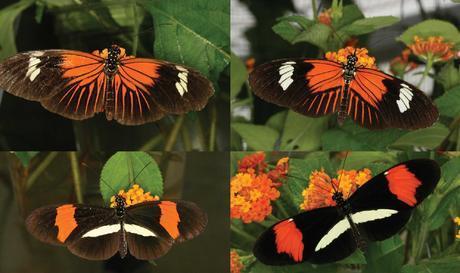
Heliconius, or passion-vine butterflies, live in the Americas -- from the southern United States to southern South America. Although they cannot interbreed, H. melpomene and H. erato have evolved to mimic one another perfectly.
These delicate butterflies have splashes of red and yellow on their black wings, signaling to birds that they contain toxins and are extremely unpalatable. They mimic one another's colour and pattern to reinforce these warning signals.
Scientists have studied these butterflies since the 1860s as a classic case of evolution in action, but only now is modern sequencing technology unlocking the underlying genetics.
The Cambridge-led team of researchers from UK and US universities, which has been breeding the butterflies in Panama for the past decade, has been searching for the genes responsible for the butterflies' wing patterns and the answer to the question of whether the same genes in two different species are responsible for the mimicry.
According to Dr Chris Jiggins of the Department of Zoology at the University of Cambridge, one of the authors of the study: "The mimicry is remarkable. The two species that we study -- erato and melpomene -- are quite distantly related, yet you can't tell them apart until you get them in your hand. The similarity is incredible -- even down to the spots on the body and the minute details of the wing pattern."
That the two species have evolved to look exactly the same is due to predation by birds. "The birds will try anything that looks different in the hope that it's good, so they learn that certain wing patterns are unpalatable and avoid them, but anything that deviates slightly from what they've experienced before is more likely to be attacked," he explains.
These butterflies have been studied since Darwin's day because they are such a striking example of adaptation. For years, scientists have pondered whether when different species evolve to look the same, they share a common genetic mechanism.
According to Jiggins: "It's interesting because it tells us how flexible evolution is. If you get the same wing pattern evolving independently in different populations, do you expect the same genes to be involved?"
Because there are thousands of genes in the butterflies' genome, most scientists felt it was unlikely that the same genes should be involved. But the results of this study suggest that this is, in fact, the case.
The new results -- published today in two parallel papers in the journal PLoS Genetics -- show that the regions of the genome associated with the wing patterns are very small -- akin to genetic "hotspots."
"This tells us something about the limitations on evolution, and how predictable it is. Our results imply that despite the many thousands of genes in the genome there are only one or two that are useful for changing this colour pattern. It seems like evolution might be concentrated in quite small regions of the genome -- or hotspots -- while the rest of it does not change very much," says Jiggins.
This is not the only unexpected element of the study. The team was also surprised that the obvious candidate genes -- such as those involved in colour or wing pattern in other species -- do not seem to be involved in the passion-vine butterflies' mimicry.
According to Jiggins: "We think it's more likely to be some novel method of cellular signaling, which is quite intriguing and could be important in many other insect species."
The next stage of the research is to look at other traits, such as behaviour, because the butterflies have preferences for particular colours and use wing patterns to select mates. "It seems the same regions of the genome control this behaviour as well as the wing pattern. We'd like to understand this," he says.
The results are published in PLoS Genetics on 5 February 2010.
The Heliconius or passion-vine butterflies are tropical butterflies from the new world that show a huge diversity of wing patterns. They have undergone rapid speciation and divergence, and also show an amazing amount of convergence in wing pattern due to mimcry. Evolutionary biologists have studied these butterflies for over 150 years, and we now know a great deal about their ecology, systematics and evolution.
They have been long-studied by scientists as an example of Müllerian mimicry -- where two poisonous or unpalatable species evolve to look the same. By contrast, Batesian mimicry describes an edible species evolving to look like a species that is toxic or unpleasant to eat.
For information on Heliconius or passion-vine butterflies, visit here.
Journal References:
1. Baxter et al. "Genomic Hotspots for Adaptation: The Population Genetics of Müllerian Mimicry in the Heliconius melpomene Clade." PLoS Genetics, 2010; 6 (2): e1000794 DOI: 10.1371/journal.pgen.1000794
2. Counterman et al. "Genomic Hotspots for Adaptation: The Population Genetics of Müllerian Mimicry in Heliconius erato." PLoS Genetics, 2010; 6 (2): e1000796 DOI: 10.1371/journal.pgen.1000796



Reader Comments
to our Newsletter